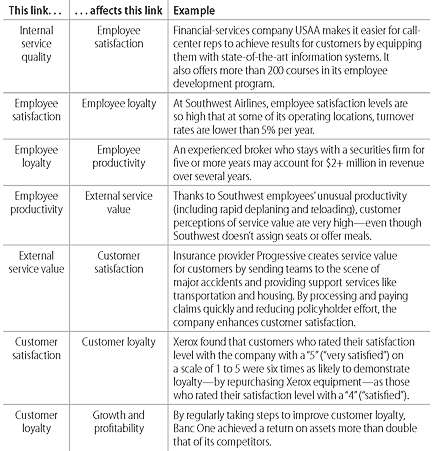Putting the Service-Profit Chain to Work
The Idea in Brief
What drives growth and profitability in a service business? Highly satisfied customers. And to keep those customers profitable, you need to manage all the aspects of your operation that affect customer satisfaction--what the authors call the service-profit chain.
Here's how the service-profit chain works: Employee satisfaction soars when you enhance internal service quality (equipping employees with the skills and power to serve customers). Employee satisfaction in turn fuels employee loyalty, which raises employee productivity. Higher productivity means greater external service value for customers--which enhances customer satisfaction and loyalty. A mere 5% jump in customer loyalty can boost profits 25%-85%.
To maximize your profits, strengthen all the links in your service-profit chain. For example, fast-food giant Taco Bell found that its stores with low workforce turnover (a key marker of employee loyalty) enjoyed double the sales and 55% higher profits than stores with high turnover. To boost profitability across stores, it enhanced internal service quality--for instance, by giving employees more latitude for on-the-job decision making.
The Idea in Practice
To optimize your profitability, the authors recommend these practices:
Understand the Links in the Service-Profit Chain
Starting with internal service quality, each link in the service-profit chain can directly strengthen--or weaken--the next:
Measure--and Manage--the Relationships in Your Service-Profit Chain
To enhance profitability, measure the relationships between links in your company's service-profit chain. Then fashion strategies for strengthening them.
To assess the relationship between internal service quality and employee satisfaction, Taco Bell: 1) Monitors internal service quality through a network of 800 numbers created to answer employees' questions, field their complaints, remedy situations, and alert top-level management to potential trouble spots. 2) Conducts periodic employee roundtable meetings, interviews, and companywide surveys to measure employee satisfaction. The results of this work prompted Taco Bell to design an employee satisfaction program that features a new selection process, improved skill building, and automation of unpleasant "back room" labor.
- Purchase the full-length Harvard Business Review article here.
- Visit Harvard Business Online.
- See more on Leadership and Managing People at Harvard Business Online.
Copyright (c) 2008 Harvard Business School Publishing Corporation. All rights reserved.
Further Reading
Articles
Why Satisfied Customers Defect
Harvard Business Review
June 2001
by Thomas O. Jones and W. Earl Sasser, Jr.
For the service-profit chain to work, your customers must be highly or completely satisfied--not just satisfied. Otherwise, they're ripe for defection to rival companies. The authors dispel the common belief that the company-customer relationship is strong with any customer who describes him- or herself as "satisfied." And they show how efforts aimed at creating highly satisfied customers are worth far more than their expense. Finally, Jones and Sasser explain ways to implement such efforts--for example, how to listen to customers and measure their loyalty.
Harvard Business Review
November 2000
by Frederick F. Reichheld
This article focuses on employee and customer loyalty--two essential links in the service-profit chain. Companies that win employees' and customers' loyalty activate a virtuous cycle: Greater customer loyalty provides enhanced profitability, which can fund better pay that attracts and retains the best workers, whose performance boosts productivity and improves customer service, which wins still-higher profits and greater customer loyalty. Reichheld explains how to identify, cultivate, and retain loyal customers; structure offerings that foster loyalty by meeting customers' ever-changing needs; and attract, recruit, and retain loyal employees.
The Service-Driven Service Company
Harvard Business Review
September 1991
by Leonard A. Schlesinger and James L. Heskett
Customer satisfaction and loyalty--key links in the service-profit chain--hinge on a service-driven logic, which stresses giving customers what they say they value. This article describes several exemplars of the service logic and identifies their distinguishing characteristics. Such firms shape their entire business to support workers who have direct contact with customers--enabling them to do what's best for customers. For example, at Taco Bell, the emphasis is always on food, service, and physical appearance: "everything else is non-value-adding overhead."
The Four Things a Service Business Must Get Right
Harvard Business Review
April 2008
by Frances X. Frei
Besides enhancing satisfaction and loyalty among employees and customers, you must manage two additional tasks to deliver services profitably: 1) Develop the right offering. Determine how customers define "excellence" in your offering: convenience? friendliness? choices? price? Identify what you will (and won't) do to deliver that excellence. 2) Fund the excellence you want to provide. Think about how you'll pay for any increased cost of the excellence you're seeking to deliver. For example, Starbucks customers value lingering in a coffeehouse setting. To fund this inviting atmosphere, Starbucks charges more for its coffee.
